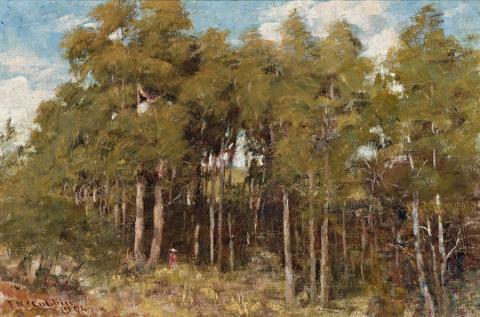A MOUNTAIN CLEARING, MACEDON, 1904
FREDERICK McCUBBIN
oil on canvas on board
29.5 x 45.0 cm
signed and dated: F McCubbin / 1904
Andrew Ivanyi Gallery, Melbourne
Private collection, Adelaide, acquired from the above in 1979
Possibly Mr Fred McCubbin's Exhibition of Australian Paintings, Athenaeum Upper Hall, Melbourne, 22 April 1904, cat. 20 (‘A Mountain Clearing, Macedon')
Macedon Hilltop, 1904, oil on canvas, 30.5 x 48.3 cm, private collection
Frederick McCubbin's early paintings of Mount Macedon witnessed the climax of his historic narrative pictures in the style of the French master realist Jules Bastien-Lepage and their triumphal move into Impressionism. A Mountain Clearing, Macedon, 1904 recalls the past and heralds the new in its freer style, full of sparkling light and enveloping atmosphere. The presence of the single figure in the landscape looks back to such paintings as Lost,1886, in the collection of the National Gallery of Victoria, Melbourne, and the tragic colonial theme of the child lost in the bush. It also recalls Gathering Mistletoe, 1886 (private collection) and Tom Roberts's A Summer Morning Tiff, 1886 in the Art Gallery of Ballarat, when the young Australian Impressionists wove tales into their studies of ladies in the landscape. McCubbin's pictures of the toils and tribulations of the early settlers achieved their apotheosis in The Pioneer, 1904, acquired by the National Gallery of Victoria through the Felton Bequest. Presented in the devotional format of the triptych, it was painted and exhibited in the same year as our work on offer. Now settled in his bush home of Fontainebleau at Mount Macedon, McCubbin's paintings of children in forest settings blossomed, as seen in What the Little Girl Saw in the Bush, 1904 and Childhood Fancies, 1905, both in private collections. His children were his models, most likely Sheila and Sydney. In Childhood Fancies Sheila wears the same bright red dress as in our painting. It is seen again in Sylvan Glade, Macedon, 1906, in the Bendigo Art Gallery, where the red of the dress is contrasted so effectively against the blue-green foliage and undergrowth. Borrowed from J.M.W. Turner, whom he greatly admired, McCubbin often used a touch of red to enliven the scene.
While the figure remains the visual focus, its narrative role has given way to compositional. The functions of colour and form have become one. Painted en plein air, A Mountain Clearing, Macedon, 1904 has the vivacity that one associates with McCubbin's later, masterly Impressionist paintings. Through the spontaneity of the technique one can sense the artist's feelings of delight in his beloved Macedon bush, of paintings devoted to expressing its quiet beauty in which the figure plays the lesser role, still with its humanizing touch. While McCubbin's Lost painted at Macedon in 1907 (National Gallery of Victoria) shows that the theme of the child lost in the bush had not disappeared from his art, the interest had changed to capturing the light and atmosphere of the shaded glade celebrated in rainbow colours of lyrical beauty. He was, as The Argus critic described him, a 'poet in colours'.1
1. Exhibition of Australian Art, Argus, Melbourne, 22 April 1904, p.7
DAVID THOMAS
